The guppy (Poecilia reticulata) is one of the most well-known and beloved aquarium fish, recognized even by those outside the hobby. For many aquarists, the guppy has been their first introduction to the world of fishkeeping, with its vibrant colors and easy care requirements making it a popular choice. In fact, many enthusiasts started their journey with a small group of guppies and, over time, have cultivated beautiful, selectively bred varieties. While a comprehensive guide to guppy care could fill an entire book, this article will address the most common questions and provide helpful insights into keeping these iconic fish.
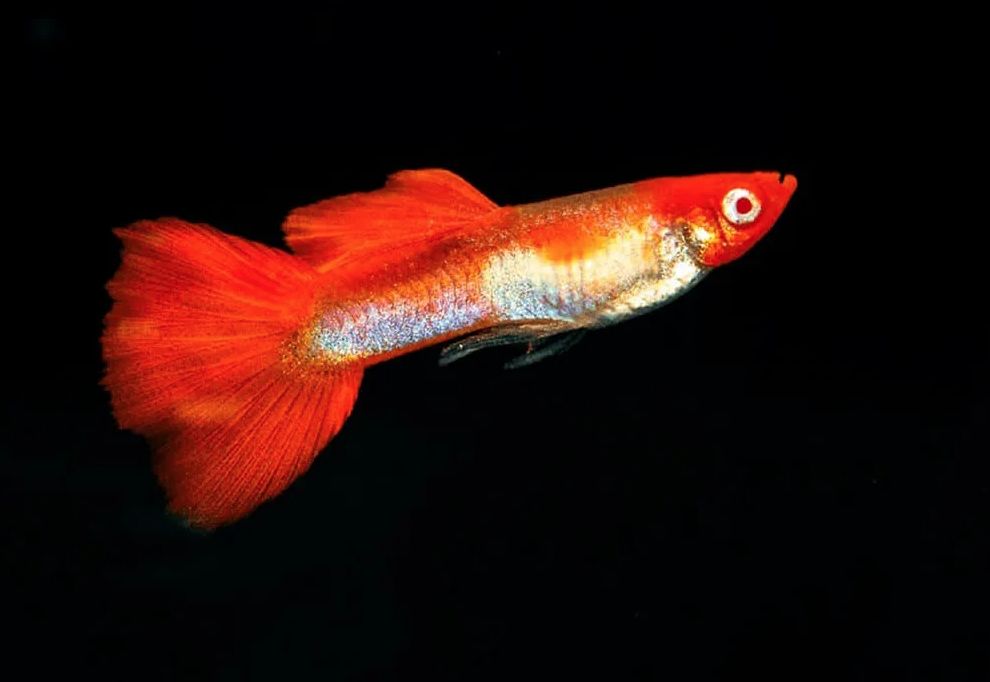
Contents
Natural habitat
Guppy fish (Poecilia reticulata), part of the Poeciliidae family, are renowned livebearers that have captivated aquarists worldwide. Their natural habitat spans tropical and subtropical regions, including Venezuela, Guiana, northern Brazil, and islands such as Barbados and Trinidad. These adaptable fish thrive in freshwater and brackish environments, often dwelling in clean, flowing waters or nearshore brackish areas, though not in fully marine conditions.
Robert John Lechmere Guppy, an English naturalist, played a key role in the fish’s discovery, and guppies were later named in his honor following his 1886 report to the Royal Society about their livebearing nature.
Guppies are tropical fish, accustomed to water temperatures between 72°F and 82°F (22°C to 28°C) in their native regions. They are also highly adaptable, able to tolerate varied water conditions, including a pH range from 6.8 to 7.8. In the wild, males are more colorful than females, but their appearance is often more subdued compared to the bright, selectively bred varieties seen in home aquariums.
Due to their dietary habits, which include feeding on insect larvae, including those of mosquitoes, guppies have been introduced globally to help control mosquito populations, further expanding their presence beyond their native habitats.
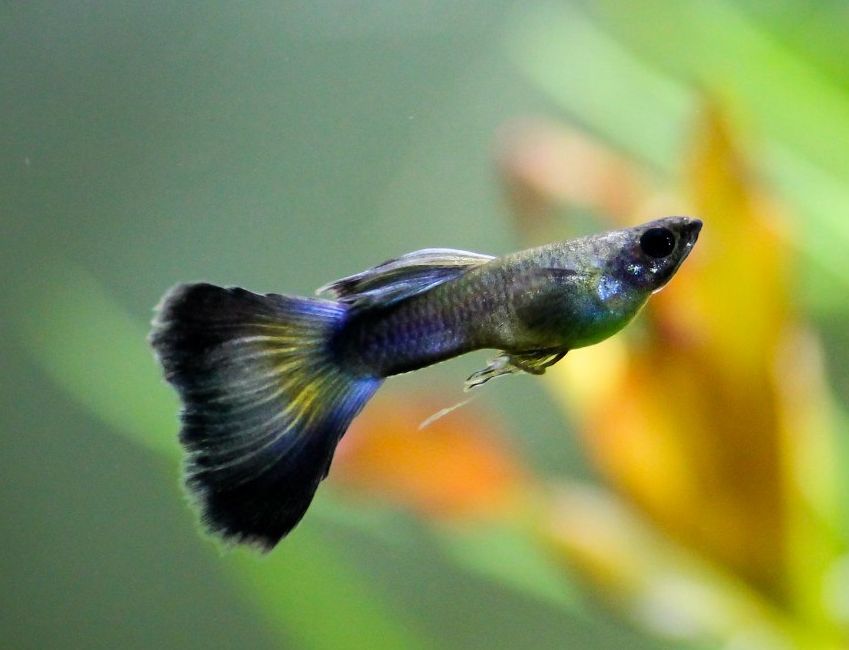
Description
Guppies are small, elongated fish characterized by a slightly rounded abdomen. They exhibit a variety of fin types and sizes, with males typically boasting larger and more elaborate fins compared to females. The dorsal fin, which runs along the back, can be long and flowing in males, while the caudal fin (tail fin) may be fan-shaped, rounded, or even lyre-shaped, depending on the strain. Their anal, ventral, and pectoral fins also vary in coloration and structure.
A notable feature of male guppies is the modified anal fin, known as the gonopodium, which serves as a reproductive organ. This elongated, curved fin helps distinguish males from females. Female guppies tend to have a slightly larger abdomen, with visible eggs in the anal region. In their natural habitats, females typically display gray scales with a distinctive diamond-shaped pattern, which inspired the name of the species, as “reticulum” means net in Latin.
The remarkable variety of colors and patterns in guppies is a result of their fast breeding and intraspecific diversity. Breeders have created an incredible array of strains featuring every conceivable combination of colors and patterns. Guppies come in a broad spectrum of hues, including red, orange, yellow, blue, green, purple, and black. Some have solid colors, while others showcase intricate patterns, spots, or stripes. Due to extensive hybridization, classifying guppies has become increasingly challenging, as new breeds emerge every year.
When classifying guppies, the primary criterion is the coloration of the body, particularly the vibrant hues of males. Other factors include the size, shape, and color of their fins.
How long do guppies live?
Guppy fish typically have a lifespan of around two years, though with optimal tank conditions, they can live up to three years. In exceptional cases, some guppies may even reach five years or more. It’s important to note that their lifespan can decrease with rising water temperatures, as higher temperatures accelerate metabolic processes.
How fast do guppies grow?
Guppies grow rapidly under optimal tank conditions. Males typically reach reproductive maturity at around two months, while females do so by three months. On average, guppies attain their full size within three to four months, although growth may continue at a slower pace throughout their lives.
In the early weeks, guppy fry experience particularly fast growth, often doubling or tripling in size within weeks. As they mature, their growth rate begins to slow.
Factors such as food quality and quantity, water temperature, and tank size significantly influence growth. A nutritious diet and optimal water conditions are essential for promoting healthy development.
How big do guppies get?
Males typically measure between 1.5 and 3.5 cm (0.6 to 1.4 in), while females range from 3 to 6 cm (1.2 to 2.4 in). Males have elongated, slender bodies that are slightly flattened on the sides. In contrast, females also have elongated bodies, but their backs are more flattened. Males are notably more vibrant in color and often boast impressive tails and fins, whereas females exhibit more subdued coloring and shorter fins.
| Characteristic | Description |
|---|---|
| Scientific Name | Poecilia reticulata |
| Family | Poeciliidae |
| Native Habitat | Freshwater streams, rivers, ponds, marshes (South America) |
| Size | Males: 1.5 to 2.4 inches (3.8 to 6 cm) |
| Females: 2 to 2.4 inches (5 to 6 cm) | |
| Lifespan | 2 to 3 years (can vary based on care and environment) |
| Sexual Dimorphism | Males are smaller, more colorful, and have elongated fins |
| Coloration | Wide variety of colors and patterns |
| Reproduction | Livebearers, females give birth to live young |
| Diet | Omnivorous, feeding on small insects, algae, and fish food |
| Water Temperature | 72°F to 82°F (22°C to 28°C) |
| Preferred pH Range | 6.8 to 7.8 |
| Behavior | Active, social, and relatively peaceful |
| Compatibility | Generally compatible with other peaceful fish species |
| Hardiness | Highly adaptable and can tolerate a range of water conditions |

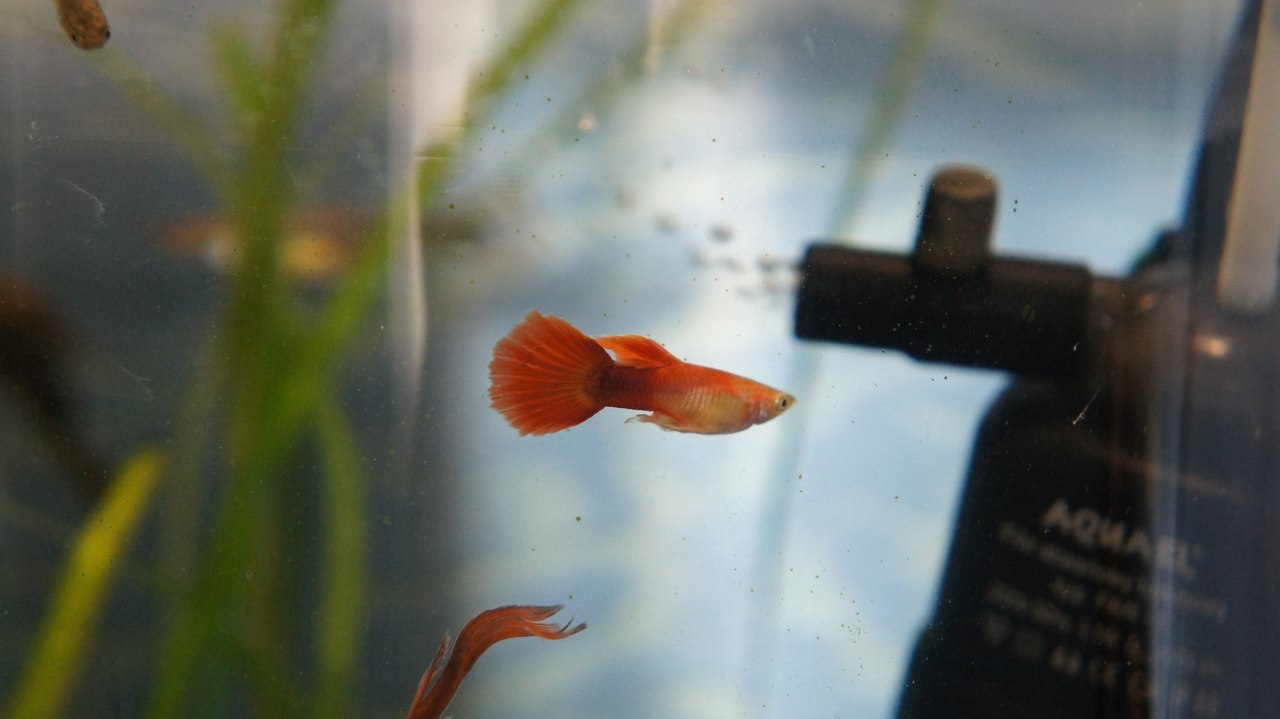
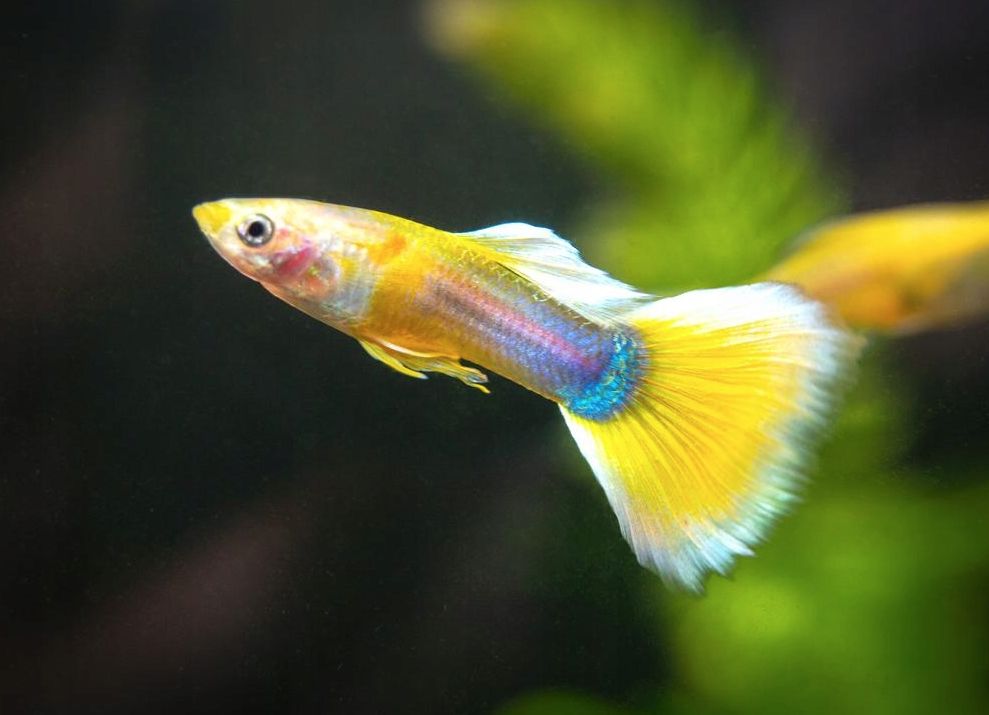
Difficulties in keeping
Guppy fish are an excellent choice for both beginners and experienced aquarists. Small, active, and visually appealing, they are easy to breed and have undemanding dietary and care requirements. However, their vibrant beauty is best showcased under optimal tank conditions.
It’s important for beginners to be cautious when selecting guppies, particularly when it comes to brightly colored varieties produced through selective breeding. If all the fish in a tank exhibit a single color and males have long, uniformly colored fins, these are likely demanding hybrids.
In contrast, guppies that feature a variety of colors and patterns among both males and females are ideal for novice aquarists. While selectively bred guppies may be stunning, they often lose the hardiness of their ancestors, becoming more challenging to care for.
Fancy guppies generally have lower immunity and require special care. Therefore, for those new to aquarium husbandry, starting with simple, multicolored guppies is advisable. These fish can be just as delightful as their more selectively bred counterparts, yet they tend to live longer and cause fewer issues.
Experienced aquarists may choose to explore these demanding hybrids, but they should be prepared for careful sorting and specialized care to ensure their health and well-being.
Care and keeping in a tank
Tank Size
The recommended tank size for guppies varies based on several factors, including the number of fish, their size, and the desired level of activity and comfort. While guppies are small, they are also very active, which means they require adequate space to thrive. A tank with a capacity of 10 gallons (about 38 liters) is suitable for a small group of 2 to 4 guppies, but providing them with sufficient room is essential for their well-being.
If you plan to keep a larger number of guppies or want to create a community tank with other species, it’s advisable to opt for a larger aquarium. A tank size of 20 to 30 gallons (76 to 114 liters) or more would be ideal to accommodate additional fish and ensure compatibility among different species.
When selecting a tank, consider its length and width, not just its volume. Guppies are active swimmers, so a tank that is at least 24 inches (61 cm) long will provide them with adequate horizontal swimming space. Additionally, a height of 12 inches (30 cm) or more allows guppies to explore different levels within the aquarium.
Another important factor is their high fertility. It’s best to have 2 to 3 females for every male in the tank. This helps reduce stress on the females, as having too few can lead to them being harassed by males. If you don’t want any offspring, it’s acceptable to keep only males in the tank.
These guidelines are meant to provide a general framework, and the specific tank size may vary based on your individual circumstances and the number of fish you plan to keep.
Water temperature
Maintaining the right water temperature is crucial for the health and longevity of guppies. While they can survive in a wide temperature range of 14°C to 33°C (57°F to 91°F), it is best to keep the tank temperature stable between 22°C and 26°C (72°F and 79°F). This range promotes optimal growth and health.
At lower temperatures, guppies tend to grow larger and can live for about 3 to 3.5 years, but they may be more susceptible to illness. Additionally, the gestation period for females increases, resulting in larger juveniles.
If the water temperature drops below 18°C (65°F), egg development can halt, and the fish’s reproductive functions may be suppressed. Conversely, at higher temperatures, guppies may have a lifespan of only about a year, and they tend not to grow as large. The gestation period shortens in warmer conditions, leading to smaller offspring.
It’s important to note that extremely high temperatures, around 30°C to 33°C (86°F to 91°F), can result in a phenomenon known as “self-castration,” where fish lose their activity and ability to fertilize eggs. Keeping guppies within the recommended temperature range ensures their health, growth, and successful breeding.
Water Parameters
Maintaining proper water parameters is vital for the health and well-being of guppies. Here are the key water parameters you should monitor:
pH Level: Guppies thrive in slightly acidic to neutral conditions, ideally with a pH around 7.0. Aim for a range between 6.8 and 7.8. Monitoring and maintaining a stable pH within this range is essential to prevent stress and health issues in your fish.
Water Hardness: Guppies are quite adaptable and can thrive in moderately hard water. Aim for a hardness level between 8 and 12 dKH (carbonate hardness) or 120 to 180 ppm (parts per million). They also tolerate brackish water, which can enhance their resilience.
Ammonia and Nitrite: Both ammonia and nitrite are toxic to guppies and must be kept at zero. Regular water testing and effective biological filtration are critical for maintaining a healthy nitrogen cycle. To prevent harmful buildup, perform partial water changes and avoid overfeeding.
Nitrate: Nitrate is the less harmful end product of the nitrogen cycle, but elevated levels can still be detrimental. Aim to keep nitrate levels below 40 ppm through regular water changes, proper filtration, and incorporating live plants, which help absorb nitrates.
Use a reliable water testing kit to regularly monitor these parameters. Conduct partial water changes of about 25% every one to two weeks to keep your guppies healthy and thriving.
Substrate
Gravel: Gravel is a popular choice for guppy tanks, available in various sizes, colors, and textures. It provides a natural appearance while allowing good water circulation. Small, dark-colored gravel can enhance the vibrant patterns of your guppies and offers a surface for beneficial bacteria, aiding in biological filtration. This substrate helps create a balanced environment.
Sand: Sand is another excellent option, offering a smooth, natural-looking bottom that is gentle on guppies’ delicate fins. It’s especially suitable if you want to create a planted tank or keep bottom-dwelling species. Make sure to choose fine-grained sand without sharp edges to avoid harming your fish.
Bare Bottom: Some aquarists prefer a bare-bottom tank, which has no substrate at all. This setup makes maintenance easier since waste can be quickly siphoned out, minimizing potential water quality issues. However, a bare bottom may lack visual appeal and could limit beneficial bacterial colonization, which is vital for tank health.
Soils: If you plan to incorporate live plants, consider a plant-specific soil substrate. These are nutrient-rich and designed to support healthy plant growth. Using a soil substrate not only promotes robust root development but also enhances the overall aesthetics of your tank, creating a thriving aquatic environment.
Decor
Avoid using plants with large, coarse leaves, as they can harm the delicate fins and tails of your guppies. Instead, opt for plants with small, soft leaves that are safe for your fish.
Adding live aquatic plants not only enhances the visual appeal of your aquarium but also offers significant benefits. Live plants help maintain water quality by absorbing nitrates, provide hiding spots for guppies, and contribute to oxygenation. Some excellent choices for guppy tanks include Java moss, Anubias, Vallisneria, Amazon sword, and Java fern. Each of these plants is well-suited to the environment and promotes a healthy habitat for your fish.
When it comes to decorations, avoid sharp-edged rocks or snag objects that could injure your fish. Instead, use smooth stones and driftwood to create caves, crevices, and hiding spots that mimic a natural habitat. These materials not only provide security for your guppies but also enhance the aquarium’s aesthetics. Ensure that any rocks or driftwood you choose are aquarium-safe and will not leach harmful substances into the water.
Filtration
Using a water filter in your guppy tank is highly advisable. An internal filter is sufficient, but if you prefer an external filter, that can work well too. Just be sure to cover the intake with fine mesh to prevent both juvenile and adult guppies from being sucked in.
While guppies are not strictly schooling fish, keeping just one pair is not ideal. These small, vibrant fish are best appreciated in groups; the more guppies you have, the more dynamic and beautiful your tank will appear. A larger number of guppies enhances the visual impact and contributes to a lively aquarium environment, making them a delight to observe.
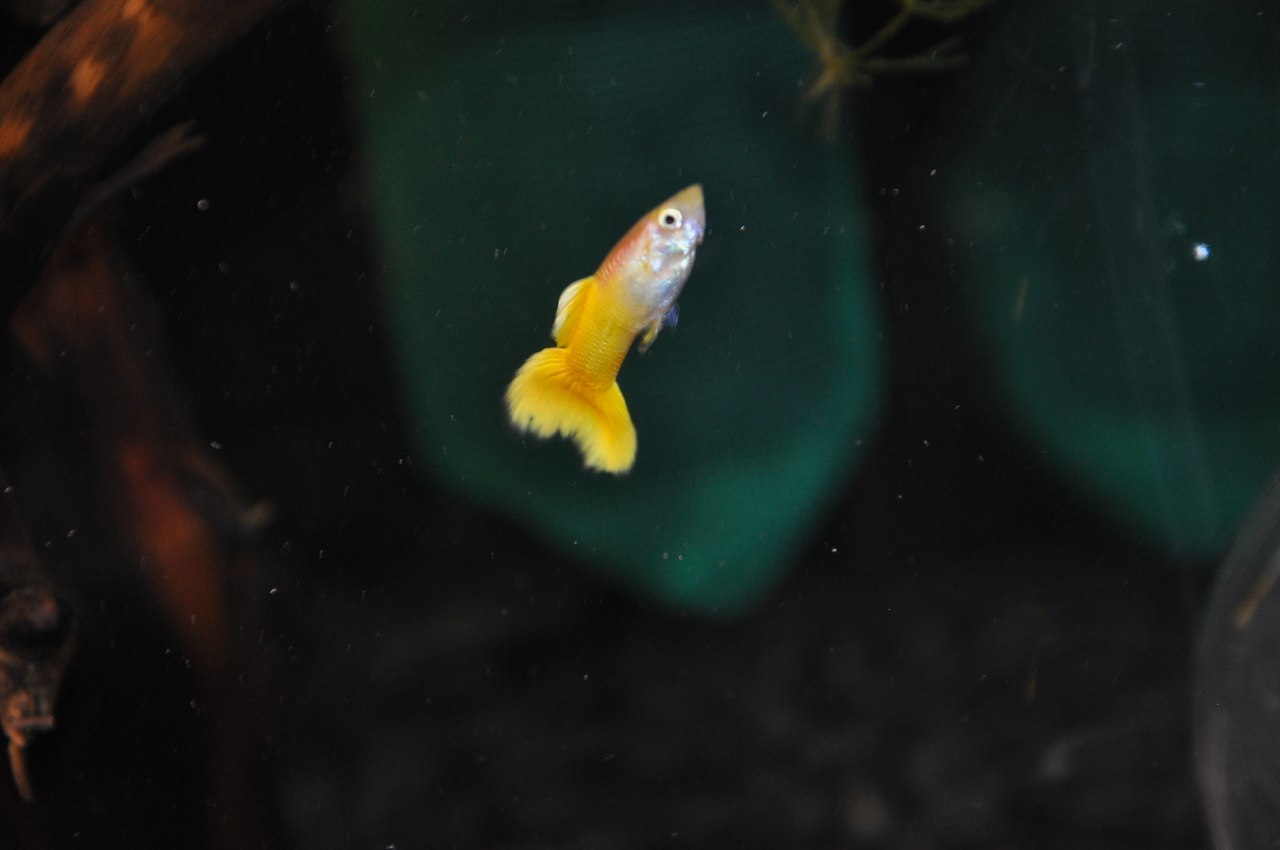
Diet
Guppy fish are easy to feed and thrive on a varied diet, which is essential for their health and vibrancy. They enjoy a mix of artificial, frozen, and live foods. High-quality fish flakes or pellets formulated for tropical fish are excellent staples, providing a balanced mix of proteins, fats, and carbohydrates. Look for reputable brands specifically labeled for guppies or tropical community fish.
In addition to dry food, guppies benefit from live offerings like bloodworms, tubifex, brine shrimp, and corethra. Given their small mouths and stomachs, it’s crucial to select appropriately sized food to ensure easy consumption.
For optimal feeding, offer food twice a day in portions that the fish can eat within 2-3 minutes. This mimics their natural feeding behavior and helps prevent overeating, ensuring they receive consistent nutrition.
Alongside regular flakes, consider incorporating vegetable-based flakes into their diet twice a week. This addition promotes a healthy gastrointestinal tract and boosts their immunity, contributing to overall well-being.
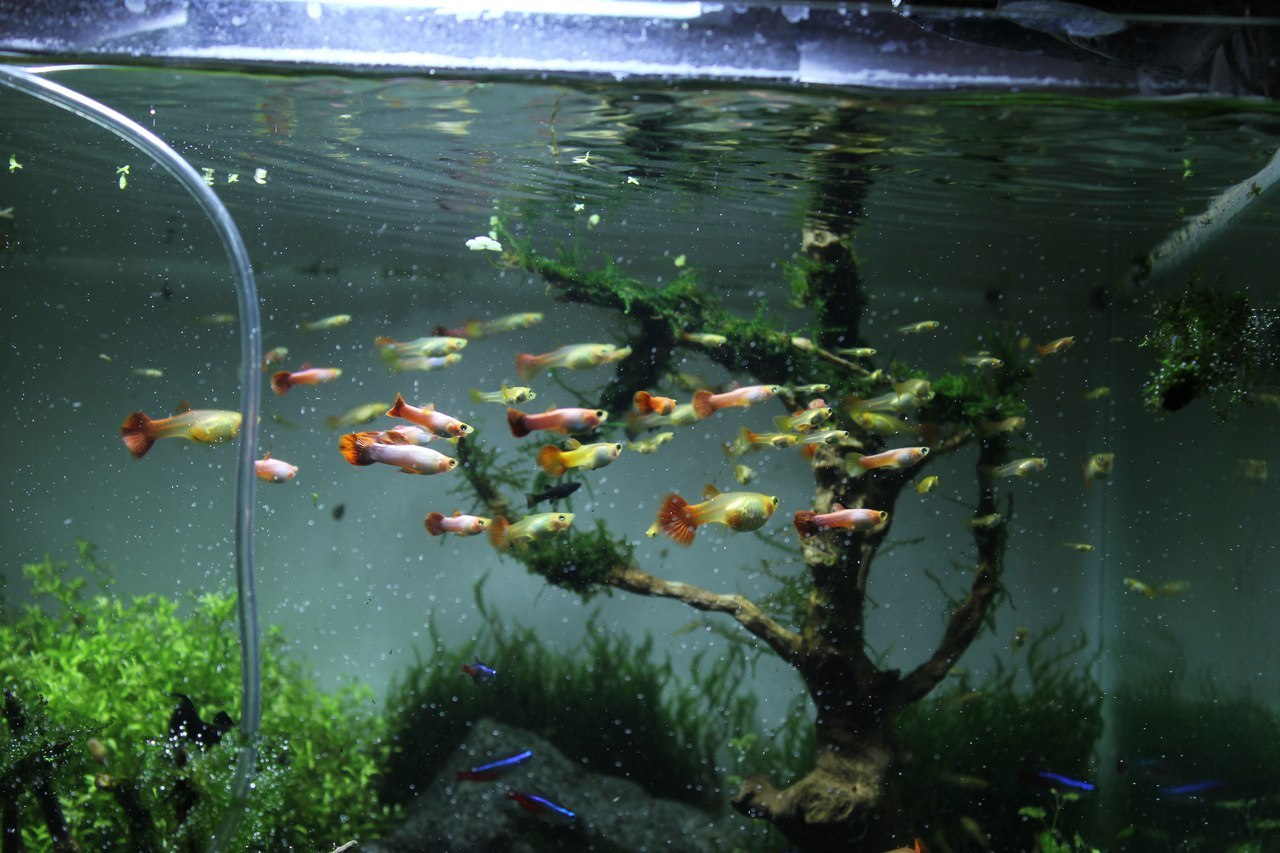
Tank mates
Guppies are very peaceful fish, making them ideal for community tanks. However, it’s important to note that they may eat their own juveniles, including those spawned by females.
When selecting tank mates, avoid large or predatory fish that view guppies as potential food, such as green terrors, angelfish, or jack dempseys. Additionally, be cautious of species that may nip at the fins of male guppies. Fish like tiger barbs, black skirt tetras, and red-eyed tetras can be particularly problematic in this regard.
Guppy fish get along well with peaceful and small fishes like:
- Harlequin Rasboras (Trigonostigma heteromorpha)
- Neon Tetras (Paracheirodon innesi)
- Ember Tetras (Hyphessobrycon amandae)
- Glowlight Tetras (Hemigrammus erythrozonus)
- Black Neon Tetras (Hyphessobrycon herbertaxelrodi)
- Cardinal Tetras (Paracheirodon axelrodi)
- Rummy Nose Tetras (Hemigrammus rhodostomus)
- Dwarf Gouramis (Trichogaster lalius or Trichogaster chuna)
- Sparkling Gouramis (Trichopsis pumila)
- Celestial Pearl Danios (Danio margaritatus)
- White Cloud Mountain Minnows (Tanichthys albonubes)
- Dwarf Rasboras (Boraras spp.)
- Endler’s Livebearers (Poecilia wingei)
- Platies (Xiphophorus spp.)
- Corydoras Catfish (Corydoras spp. – pygmy cory, panda cory, adolfoi catfish)
- Otocinclus Catfish (Otocinclus spp.)
- Bristlenose Plecos (Ancistrus spp.)

Gender differences: male vs female
Fancy guppies, like other guppy varieties, exhibit sexual dimorphism, meaning there are clear differences between males and females. Understanding these differences can help aquarists appreciate their behavior and care needs.
Size: Males are generally smaller than females. Adult males typically reach a size of 1.5 to 2.4 inches (3.8 to 6 cm), while adult females can grow slightly larger, up to 2 to 2.4 inches (5 to 6 cm).
Coloration: Male fancy guppies are celebrated for their vibrant colors, displaying a dazzling array of hues such as red, blue, yellow, green, orange, and black. Their bodies and fins are often adorned with intricate patterns, making them visually striking. In contrast, females tend to have more subdued colors, usually appearing in solid or muted tones.
Fins: Males possess longer and more elaborate fins compared to females. Their dorsal fins can be particularly impressive, while their caudal fins (tail fins) are often larger and more ornate, featuring unique shapes like fans or lyres. Female guppies, while still having fins, are characterized by shorter and less elaborate designs.
Gonopodium: A key distinguishing feature of male guppies is the gonopodium, a modified anal fin used for reproduction. This elongated, curved structure is absent in females, who do not have this specialized reproductive organ.
Behavior: Male fancy guppies are typically more active and exhibit energetic behaviors, such as courtship displays to attract females. They often engage in fin displays and chasing. Females, while also active, tend to be more reserved and less inclined to perform flashy behaviors.

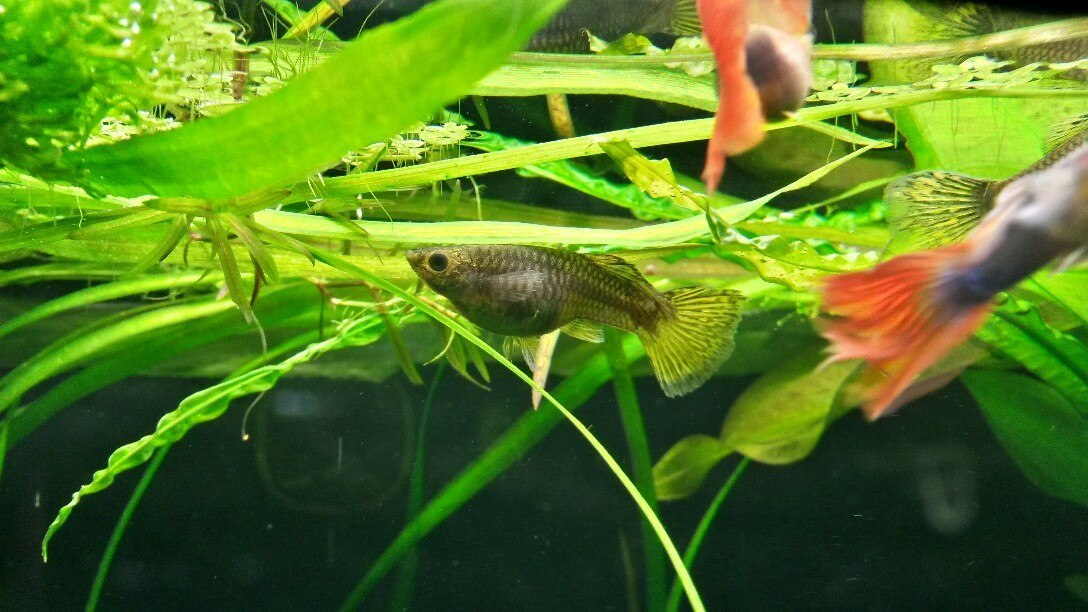
Breeding
Guppy fish are among the simplest fish to breed, making them a favorite for beginner aquarists. As livebearers, guppies carry eggs internally and give birth to fully formed juveniles. In their first hours, the fry tend to hide, but they quickly become active swimmers and begin feeding.
Breeding Readiness: Guppies typically reach sexual maturity at around 2 to 3 months of age, though this can vary based on factors like genetics and environmental conditions. For successful breeding, you only need one active male and a few females; a single male can court 3 to 5 females simultaneously.
Breeding Setup: To facilitate breeding, provide fresh, clean water and high-quality food. Guppies can breed successfully in a community tank, but since they may eat their own fry, it’s best to transfer pregnant females to a separate tank with similar water parameters and hiding spots for the fry.
Identifying Pregnant Females: You can tell when a female is pregnant by observing the area near her anal fin, which will darken as she nears the time to spawn. Once she is ready, place her in a designated breeding tank.
Gestation and Fry Care: The gestation period lasts about 21 to 40 days, depending on water temperature. Females can give birth to anywhere from 10 to 200 fry at a time. Notably, one mating can result in multiple batches of fry over several months, as females store sperm and can fertilize eggs multiple times.
After spawning, remove the female from the breeding tank to prevent her from eating the fry. Caring for the fry is straightforward; feed them finely crushed branded food, similar to what adults eat, but it’s best to use special food formulated for fry.
To maintain a clean environment, clean the tank regularly to prevent food debris from rotting. You can also introduce snails, such as apple or ramshorn snails, which will consume leftover food without harming the fry.
Water Quality: Keeping the water clean is crucial, but avoid making large water changes all at once, as this can stress the fry. Instead, aim to change about 10% of the water every 1-2 days or 25% once a week.
Temperature: Maintain the water temperature between 24-26.5°C (75-80°F) for optimal fry growth. With proper care and nutrition, the fry will grow quickly and start developing their colors within 1 to 1.5 months.